Discover Oahu's Top Surfing Beaches for All Levels
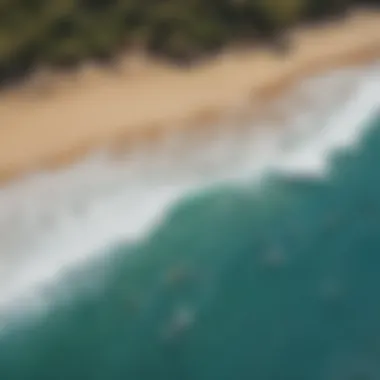
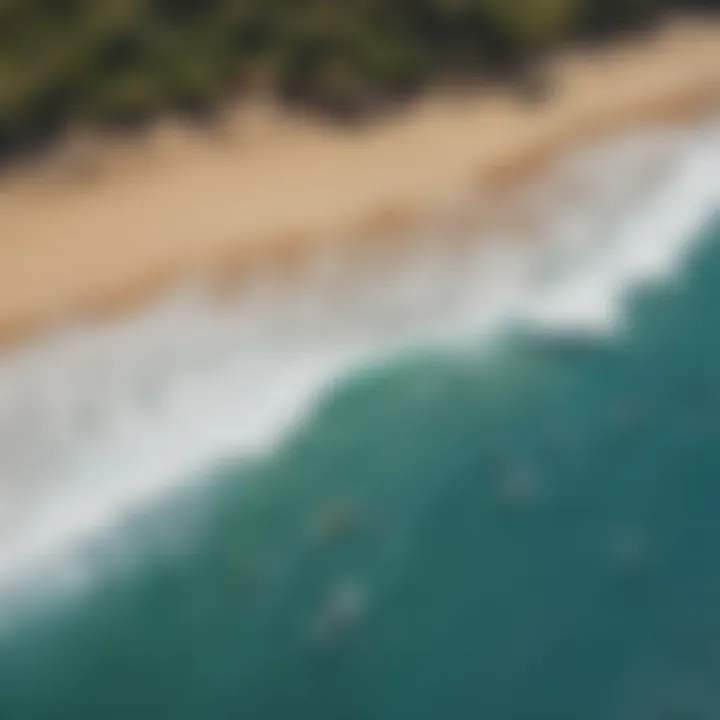
Intro
Oahu, often dubbed as the "Gathering Place," is not just a picturesque vacation spot; it's a haven for surfers. Whether you're a seasoned pro or a newbie, this island offers surf breaks that cater to all skill levels. With its rich local culture and stunning landscapes, each beach presents a unique experience. The essence of surfing in Oahu isn’t just about catching waves, it’s also about immersing oneself in the vibrant community surrounding the sport. In this article, we aim to explore some of the best surfing beaches Oahu has to offer, unpacking their distinct characteristics, local culture, and essential tips for staying safe while riding the waves.
Key Points to Discuss:
- Overview of essential surfboard types and recommendations
- Techniques for surfers at every ability level
- Examination of individual beach features, local customs, and safety considerations
By providing a thorough understanding of these elements, surfers can confidently navigate both the waves and the culture, ensuring an enriching adventure on this Hawaiian gem.
Surfboard Reviews
As any surfer knows, selecting the right surfboard is crucial for a successful day out on the waves. Different boards cater to different styles, conditions, and skill levels.
Types of Surfboards: An Overview
There are several types of surfboards, each offering a distinct experience:
- Shortboards: These boards are favored by advanced surfers looking for speed and maneuverability. Their smaller size allows for sharp turns and quick responses to wave actions.
- Longboards: Perfect for beginners and those who enjoy a more relaxed surfing style. Longboards provide greater stability and make it easier to ride smaller, slower waves.
- Fish Boards: With a wider nose and a shorter outline, fish boards are ideal for a variety of wave conditions, offering a blend of stability and performance.
- Funboards: A hybrid that combines features of longboards and shortboards, funboards cater to those transitioning from beginner to intermediate levels.
Choosing the right board can feel daunting, but understanding these key differences can simplify the selection process.
Best Surfboards for Beginners and Pros
For beginners, a soft-top longboard like the Wavestorm is recommendable. It offers stability and durability, making it a perfect introduction to the sport. Pros often gravitate towards high-performance shortboards like the Channel Islands' Rocket Wide, designed to handle powerful waves with ease.
It's essential to match the board with the surfer's weight, ability, and the typical ocean conditions in Oahu to ensure an enjoyable surfing experience.
Surfing Techniques
Understanding the necessary skills is just as important as selecting the right equipment. Mastering various techniques can greatly enhance one's surfing performance.
Essential Techniques for Beginners
- Paddling: Effective paddling is crucial for positioning on the wave. Ensure your torso is centered on the board for better balance.
- Pop-Up: This technique involves swiftly transitioning from a lying position to standing on the board as the wave approaches. Practice this on land before hitting the water.
Advanced Maneuvers for Experienced Surfers
- Bottom Turn: This is foundational for generating speed and transitioning into sharper turns. Engage your hips to maintain balance.
- Carve: This maneuver allows for powerful turns while maintaining speed. Weight distribution is key; lean into the turn while ensuring your body remains centered over the board.
By mastering these techniques and selecting the right gear, surfers can fully embrace the waves that Oahu has to offer. Let's continue to explore the stunning beaches that have made this island a legendary surf destination.
Intro to Oahu's Surfing Landscape
Oahu, often referred to as the "Gathering Place," is not only a tropical paradise but also a vital hub in the world of surfing. Its beaches attract surf enthusiasts from all corners of the globe who come seeking the perfect wave, whether they are beginners or seasoned veterans. The importance of this section lies in understanding the diverse surfing landscape that Oahu offers.
Surfing in Oahu is more than just a sport; it's a way of life deeply rooted in the island's culture. The variety of beaches and their unique characteristics create an ecosystem where surfers can connect with nature and embrace both the challenges and joys that come with riding the waves.
Key Elements of Oahu's Surfing Landscape
- Diversity of Beaches: Oahu boasts an array of surfing spots that cater to different skill levels—from the gentle, rolling waves of Waikiki to the fierce breaks at the North Shore. Each location has its own personality, creating a rich tapestry of surfing experiences.
- Cultural Relevance: Understanding the surfing culture is crucial for surfers and visitors alike. Surfers often bond over their shared passion, forming a community that respects the ocean and its traditions. The spirit of Aloha flows strongly among those who surf, fostering a sense of belonging that transcends the waves.
- Environmental Considerations: Oahu's natural beauty is breathtaking, but with it comes the responsibility to protect the environment. Surfing here involves not only enjoying the waves but also understanding the local ecosystem and the impact surfing can have on it.
- Skill Development Opportunities: For those looking to hone their skills, Oahu offers various workshops and lessons led by local instructors who possess a wealth of knowledge about the waters. This educational aspect enriches the surfing experience and connects newcomers with seasoned pros.
"Surfing is a journey of connection—to the ocean, to oneself, and to others who share this passion."
In essence, Oahu’s surfing landscape is multifaceted and continually evolving. Each wave tells a story, every beach has its distinct flavor, and the surfer's experience is shaped by the intricate interplay of skills, local culture, and respect for nature. As we dive deeper into specific surfing beaches, this foundational understanding will enhance the appreciation and enjoyment of what Oahu has to offer.
Hawaii: A Historical Context of Surfing
Understanding the historical backdrop of surfing in Hawaii is pivotal for grasping its current significance in the surfing culture worldwide. Surfing, or he'e nalu as it's known in Hawaiian, goes beyond mere physical activity; it encapsulates a profound connection to the ocean, land, and community. This context not only enriches the experience for surfers but also reflects the cultural identity of the Hawaiian people. From ancient rituals to modern-day competitions, the evolution of surfing in Hawaii reveals much about the islands' cultural resilience and adaptability.
Cultural Roots of Surfing in Hawaii
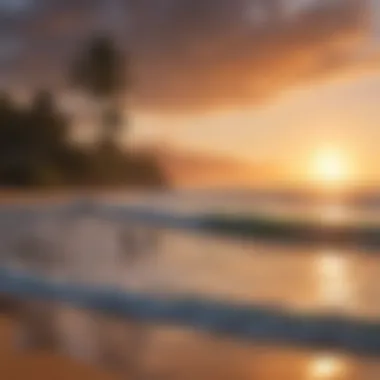
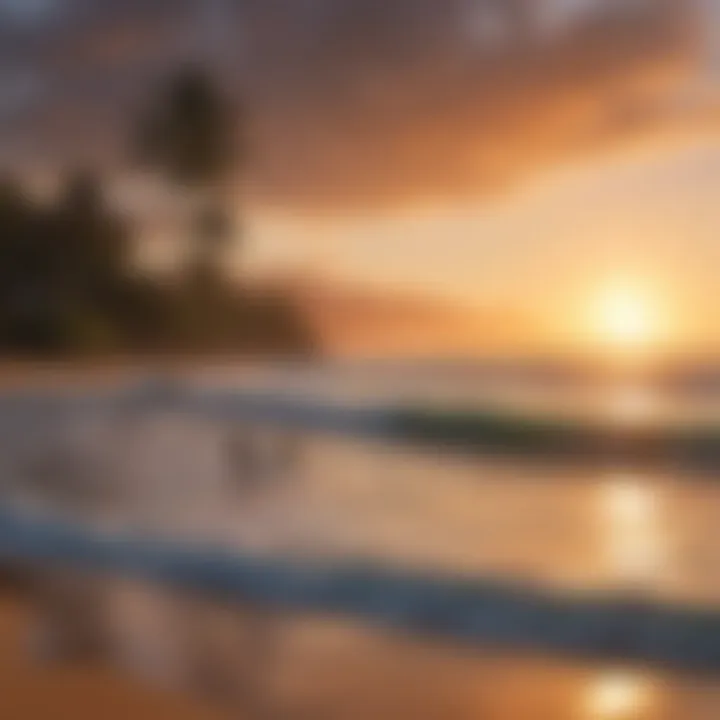
Surfing’s roots in Hawaii stretch back for centuries, interwoven with the islands’ cultural fabric. In ancient times, surfing was more than an enjoyable pastime; it was a rite of passage. Young Hawaiians would often start learning to surf at an early age, carving their first boards from local wood, often from koa trees. There was a rich narrative that surrounded surfing—much of it steeped in spirituality.
The ancient Hawaiian way of life embraced the ocean as a sacred entity. Surfing was not just about riding waves; it was a demonstration of one's connection to their surroundings.
Moreover, ali'i (chiefs) and their family members were famous for their surfing skills. It was almost a means of establishing status, and competitions could often dictate societal standing. Interestingly, specific surfing spots were considered sacred, and their usage was governed by a set of rules that wove respect into the sport.
Evolution of Surfing Techniques
As the years rolled on, surfing began to transform significantly, evolving from its ancestral roots into a sport that now captures attention on a global scale. The 19th century saw a surge in interest from outsiders, particularly American and European visitors who were captivated by the idyllic scene of sun, surf, and prowess. This led to innovations in board design and surfing techniques.
Surfboards transitioned from heavy wooden planks to lighter, more maneuverable versions, influenced by technological advancements. The introduction of fiberglass in the 1950s revolutionized the industry, leading to a dramatic shift—surfboards became not only functional but also a symbol of lifestyle and identity.
Techniques progressed from the simple foot placement to nuanced maneuvers, reflecting an ever-growing understanding of wave dynamics. Surfers familiarized themselves with the intricacies of various surf spots, learning to read the ocean's pulse, tide changes, and swell patterns.
Through this lens, one can appreciate how surfing in Hawaii has been a constant dialogue between tradition and innovation, where every surfer, past and present, contributes to an evolving culture that is vibrant and diverse.
Top Surfing Beaches in Oahu
Oahu's coastline is a surfer's paradise, serving as the backdrop for countless enthusiastic riders. The allure of the best surfing beaches in Oahu lies not just in the waves but also in their unique characteristics, cultural significance, and varied conditions that appeal to every level of surfer. This section highlights some of the most noteworthy surf spots, enabling you to choose the perfect beach for your surfing adventure.
Waikiki Beach
Unique Features
Waikiki Beach, with its golden sands and towering palms, is a sight to behold for both tourists and avid surfers alike. What sets this beach apart is its shallow waters and consistent small to moderate waves. This makes it particularly inviting for surfers who favor long rides over challenging barrel waves. The charm of Waikiki isn't just in its surf; it’s also a hub for local surf schools offering lessons to beginners. People flock here to soak in the sun, making it a social hotspot outside of the surfing experience.
Best Times to Surf
The optimal times to surf at Waikiki are during the summer months, from May to September. The waves tend to be more manageable then, making it a perfect fit for beginners. However, this doesn’t mean the waves aren’t fun for seasoned surfers too. Early mornings during weekdays offer smaller crowds, allowing for a more laid-back session. A clear sky can enhance the experience, yet the beauty of Waikiki shines in its own way, even when the clouds roll in.
Surfer Skill Levels
Waikiki caters to an array of surfers. It’s widely known as a beginner-friendly beach, but there are portions where advanced surfers can catch some exciting waves as well. The gradual sandy bottom means that novices can practice safely, while the more seasoned riders can still find areas with stronger waves for a thrilling challenge. Because of this versatility, Waikiki remains a cherished beach in the surfer community until today.
North Shore: The Surfing Mecca
Pipeline: The Iconic Wave
Pipeline is perhaps Oahu's most famous surf break, renowned for its powerful, hollow waves that create a breathtaking spectacle. Surfers from around the globe visit this spot to test their skills against its legendary waves. The unique geographical features, like the reef just offshore, contribute to the wave's formation, often resulting in thrilling, yet dangerous conditions. Despite its challenges, the adrenaline rush of riding a Pipeline wave leaves a lasting mark on the hearts of those brave enough to tackle it.
Sunset Beach: Beauty and Challenge
Sunset Beach is known for its stunning sunset views and challenging waves. It has become a stage for international competitions, attracting elite surfers who are eager to compete during the winter months. The beach presents both the beauty of nature and the thrill of action, making it a favorite amongst spectators too. However, riders need to be aware of the seasonal swells that can catch many off guard, reminding each surfer of the respect due to Mother Nature.
Waimea Bay: Seasonal Swells
With its gigantic waves during the winter season, Waimea Bay offers one of the biggest surfing challenges in the world. The beauty of this beach combined with the power of its waves draws in experienced surfers eager to push their limits. However, it is crucial for those who choose to surf here to be fully aware of the conditions, as the swells can escalate quickly. The allure of Waimea Bay is both the excitement of conquering nature and the solidarity found among local surfers who often gather to ride its famed waves.
Makapu'u Beach
Wave Conditions
Wave conditions at Makapu'u are known for their consistency, making it an excellent spot for surfers of varying skill levels. The formations created by the surrounding rocky coastline help to funnel swells effectively, providing clean waves. This beach is particularly suitable during the winter months, when larger swells arrive, attracting more experienced surfers eager for adventure. However, it’s essential to be aware that conditions can change rapidly, requiring a good degree of skill to navigate successfully.
Safety Considerations
Surfers heading to Makapu'u Beach should carefully consider safety, especially regarding the presence of rocky reefs and fast currents. Lifeguards patrol the area, but understanding the potential hazards is crucial. The waves may be enticing, but they come with a degree of risk; beginners should avoid certain areas unless accompanied by seasoned surfers or instructors. Staying informed is key to ensuring a safe and enjoyable surfing experience in this scenic location.
Accessibility
Makapu'u Beach is somewhat accessible, with parking available nearby. There are pathways leading down to the beach, but a bit of a trek may be necessary. Those with mobility issues might need to plan accordingly, though the picture-perfect scenery makes the effort worthwhile. Given its proximity to other attractions, it can easily be included in a day’s adventure on the island.
Kailua Beach
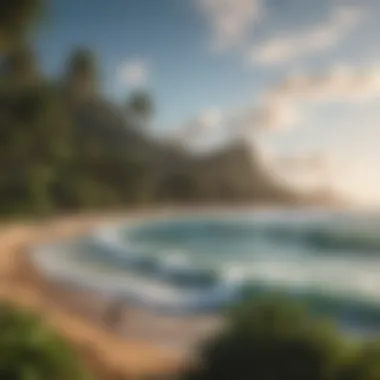
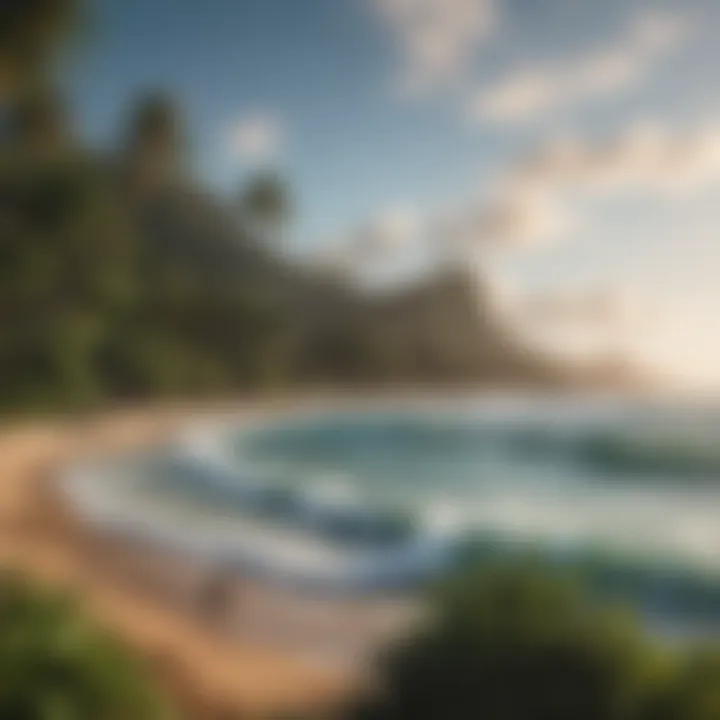
Beginner-Friendly Atmosphere
Kailua Beach stands out for its calm and welcoming waters, ideal for beginners who want a stress-free introduction to surfing. The sandy bottom and gentle waves create a safe environment for learning. This friendly atmosphere boosts confidence among novices, many of whom come to not just surf but also enjoy paddleboarding and kayaking. The beach has a relaxed vibe that encourages enjoyment of the ocean without the intimidation often present at more challenging surf spots.
Water Activities
Besides surfing, Kailua Beach boasts an array of water activities that attract families and groups. From paddleboarding to snorkeling, the beach's clean and clear waters make it a favored spot for many. On calm days, the waters become a playground, where surfers can segue into other water-related fun. The variety of options makes it appealing for both surf enthusiasts and those looking to unwind in the water.
Local Amenities
Kailua Beach is well-equipped with local amenities that enhance the overall experience. Nearby cafes and rental shops provide surfers with gear and refreshments, allowing them to spend the entire day soaking in the sun and waves. The supportive local environment makes it easier for visitors to get involved with the community—creating opportunities to improve surfing skills while making new friends.
Laniakea Beach
Surfing with Turtles
Laniakea Beach is unique not just for its waves but also for its friendly resident sea turtles. Surfers often have the rare opportunity to share the water with these gentle giants, creating an unforgettable experience. Respecting marine life is essential, so surfers are encouraged to be cautious and to maintain a safe distance. The presence of turtles adds a layer of magic to the surfing experience that cannot be easily replicated.
Best Surfing Conditions
Ideal surfing conditions at Laniakea typically occur during the winter months, when swells bring exciting waves. The beach, with its backdrop of lush greenery, can draw surfers looking for great conditions and stunning views. However, as the waves increase in size, it's crucial for surfers to assess their own abilities versus what is on offer, ensuring they challenge themselves only within safe limits.
Local Community Insights
The local community plays a vital role at Laniakea, where seasoned surfers often share tips and insight with newcomers. This strong sense of community not only enriches the surfing experience but also fosters a respect for the environment and its inhabitants. Engaging with locals can deepen your understanding of not just the waves, but the culture surrounding surfing in Oahu as well.
Whether a seasoned pro or a eager beginner, Oahu has a wave waiting for you. The islands are full of varied surf spots that promise unique experiences, each beach with its own distinctive charm.
Evaluating Surf Conditions and Safety
Understanding surf conditions and safety is not just an afterthought but an integral part of ensuring enjoyable and, more importantly, safe surfing experiences. Surfers—from novices to experts—interact with unpredictable waves and tides, and being in the know can make all the difference between an exhilarating ride and a perilous fall. Recognizing the ocean's moods can help in making informed decisions about when and where to surf, thus maximizing fun while minimizing risk.
Understanding Rip Currents
Rip currents can be a silent adversary for a surfer. These swift, narrow channels of water flow from the shore outwards, creating strong pull that can catch even seasoned surfers off guard. Understanding how to identify and deal with them is crucial. Here’s what to look out for:
- Color and Texture Change: Look for darker water, which often indicates depths, and foamier patches which signal turbulent water.
- Sand Movement: Noticeable differences in the sand near the water's edge can indicate a rip current. If you're seeing a narrow pathway of sand moving away from the beach, it could be a sign.
- Swimmers: If you'll see swimmers getting pulled away while others struggle to return to shore, that can give you a heads-up as well.
Although rip currents can be alarming, knowing how to react is vital:
- Don't Panic: Many surfers tire themselves out by fighting against the current. Instead, swim parallel to the shore until you escape the grip.
- Swim Back to Safety: Once out of the current's path, you can then swim back to the beach at a diagonal angle.
"Education on rip currents can prevent panic and misjudgments, turning a potentially dangerous situation into just another day at the beach."
Importance of Local Knowledge
Local knowledge is akin to a surfer's secret weapon. Each beach has its unique quirks, and understanding these can significantly influence your surfing experience. The local surfer community often holds invaluable insights that aren't found in any guidebooks. Here's why it matters:
- Surf Breaks: Locals know the characteristics of specific breaks. They can tell you when and where waves are best for different skill levels, saving you a lot of guesswork.
- Weather Patterns: Being familiar with local weather patterns and seasonal changes can make or break your surfing plans. Sometimes, just a slight shift can lead to completely different surf conditions.
- Beach Etiquette: Understanding the unspoken rules of the water helps maintain harmony among surfers. Each region may have its traditions, including who has the right of way on a wave.
In essence, not recognizing the vital combination of evaluating surf conditions and leveraging local knowledge could lead to missed opportunities and increased risks. Whether you’re just starting or are a seasoned veteran, take time to learn and connect with the local surf community. Your experiences on Oahu’s shores will certainly be richer for it.
The Role of the Surf Community
Oahu’s surfing scene isn’t just about the breathtaking waves and pristine beaches; it thrives on a rich tapestry of community spirit, where shared experiences foster a sense of belonging among surfers. The surf community plays a pivotal role in nurturing both the sport and the culture surrounding it. From seasoned veterans to enthusiastic newcomers, the bond formed through a shared love of surfing creates an environment that is as educational as it is enjoyable.
Surf Competitions: A Tradition
Surf competitions on Oahu aren’t merely contests; they are vibrant celebrations of skill and camaraderie that transcend individual rivalries. Events like the Vans Triple Crown of Surfing draw not only top-tier professionals but also local surfers who showcase their talent. These competitions serve several important functions:
- Cultural Significance: They highlight the historical roots of surfing in Hawaii, reinforcing traditions that date back centuries.
- Skill Development: For many surfers, these events are crucial stepping stones for honing their skills. Competitors get the chance to learn from each other, pushing their limits in a supportive yet challenging environment.
- Community Engagement: Local participants rally around these events, fostering a spirit of collaboration that extends beyond the contest itself. It creates a platform for connecting surfers of diverse backgrounds.
- Sustainability Awareness: Many competitions actively promote eco-friendly practices, raising awareness about preserving Hawaii’s natural beauty that brings us together.
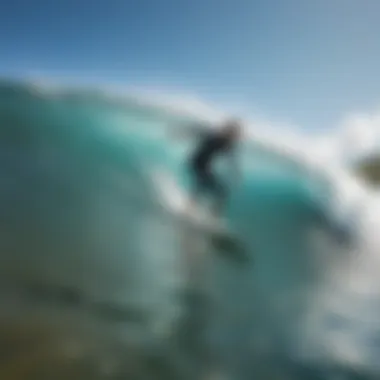
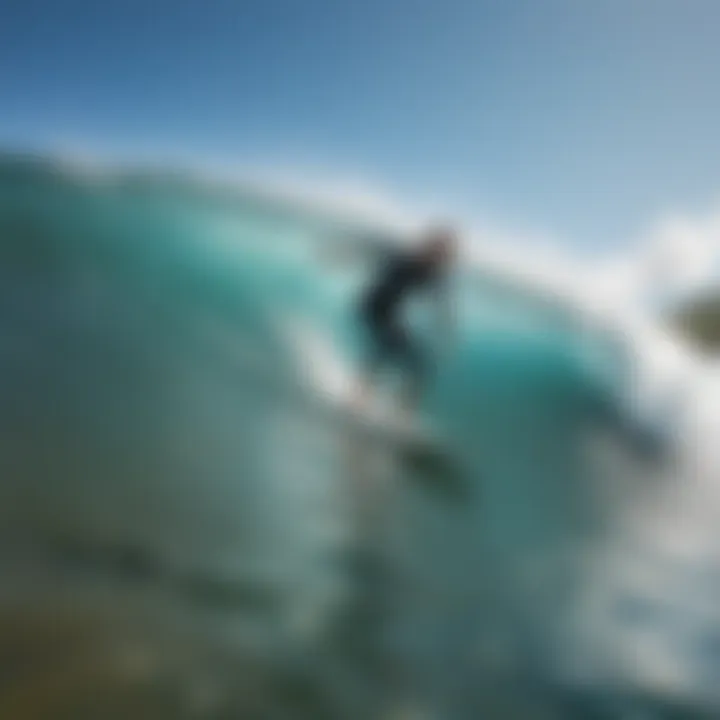
Whether you’re watching from the shore or prepping for your heat, the palpable energy of these competitions reflects the heart and soul of the surf community.
Supporting Local Surfers
In Oahu’s surfing landscape, supporting local surfers is a cornerstone of the surf community. The interdependence of locals and visitors creates a unique dynamic that benefits everyone involved. Here are a few ways in which this support manifests:
- Mentorship: Experienced surfers often take it upon themselves to guide newbies, offering tips on wave reading and etiquette. This transfer of knowledge helps ensure that everyone, regardless of skill level, can enjoy the ocean safely and responsibly.
- Grassroots Sponsorships: Many local businesses sponsor surfers, helping them afford gear and entry fees for competitions. This not only boosts local talent but also strengthens community ties.
- Social Media and Online Platforms: Communities frequently share tips, conditions, and experiences on platforms like Facebook and Reddit. This digital camaraderie extends beyond the water, forging connections that last long after the sun sets.
- Local Events and Gatherings: Sundays at the beach often see informal meetups where surfers come together not just to ride but to share in food, stories, and laughter. These events cultivate unity and provide a deeper understanding of the local culture.
"Surfing is not just a sport; it’s a unifying force that transcends individual ambitions and nurtures a community spirit that is invaluable."
In essence, the role of the surf community in Oahu extends well beyond the waves, creating an atmosphere rich with solidarity, education, and cultural pride. Surfers find solace and motivation in each other's company, which ultimately enhances the overall experience of riding the iconic Hawaiian waves.
Environmental Considerations in Surfing
Surfing is often seen merely as a thrilling activity or a recreational pastime; however, the environmental aspects surrounding this coastal sport can't be overlooked. The ocean is not just a wave machine; it is a complex ecosystem that provides for countless marine species and supports coastal communities. Protecting these environments is essential, not just for maintaining the quality of our ocean experiences, but also to ensure the sport’s future viability.
Understanding the intricate balance between man and nature leads to more informed surfers who are aware of their impacts. As enthusiasts navigate through their surf adventures, they should recognize their role in preserving these irreplaceable environments. Not only does this contribute to the health of coastlines and oceans, it fosters a culture of respect and responsibility among surfing communities.
Sustainable Surfing Practices
Sustainable surfing practices encapsulate the various actions surfers can take to mitigate their environmental impact. These practices range from personal choices to wider community initiatives. Here are a few key elements that surfers should consider:
- Eco-Friendly Equipment: Opting for boards made from sustainable materials such as bio-resins instead of conventional ones can significantly reduce environmental footprints. Some companies offer surfboards crafted from recycled materials, which help minimize waste.
- Beach Clean-Ups: Participating in or organizing local beach clean-ups not only helps keep the shoreline pristine but also fosters community spirit among surfers. Picking up trash after a session reminds everyone why preserving this beautiful landscape matters.
- Educating Others: Sharing knowledge about ocean conservation can amplify its effects. If every surfer commits to educating one person about the impact of pollution and waste, a ripple effect in awareness will occur, creating a more conscientious surfing community.
- Respecting Wildlife: Being mindful of local marine life while surfing ensures that surfers are not disturbing fragile ecosystems. This includes steering clear of nesting areas and being aware of seasonal migration patterns.
"Surfers have a profound relationship with the ocean, and with that connection comes the responsibility to care for it."
By being proactive in these areas, surfers can help sustain a symbiotic relationship with the ocean, ensuring the waves roll on for generations to come.
Conservation Efforts in Oahu
Oahu is not only famous for its breathtaking beaches but also for the initiatives designed to protect its unique marine ecosystem. Several organizations and local communities are actively engaged in conservation efforts that help maintain the health of its waters and beaches.
- Marine Protected Areas (MPAs): Certain zones in Oahu have been designated as protected areas, allowing marine life to flourish without human interference. These areas serve both ecological and educational purposes, displaying biodiversity while providing a sanctuary for vulnerable species.
- Reef Restoration Projects: Various initiatives focus on reef rehabilitation, helping to restore coral populations that might be suffering from environmental stressors. Volunteers often participate in planting new corals, fostering a deep connection to the ocean through hands-on involvement.
- Public Awareness Campaigns: Local agencies frequently run campaigns to educate both residents and tourists about pollution and its impact on marine life. Initiatives may include socially engaging platforms like beach workshops and informational seminars.
- Collaboration with Scientists: Oahu combines traditional surfing practices with modern science by partnering with marine biologists. The goal is to garner insights into the ocean's health, leading to more informed conservation strategies and practices.
Understanding the importance of these conservation efforts invites surfers to be part of the solution, rather than contributing to the problem. By embracing their roles as stewards of the ocean, surf enthusiasts can enjoy their beloved waves while ensuring that they are preserved for future adventurers.
Preparing for Your Surfing Adventure
When it comes to surfing in Oahu, preparation is key. The waves may be inviting, but surfing can be unpredictable and often requires a fair amount of foresight. Proper planning not only enhances one’s experience but also significantly contributes to safety on the water. This section aims to equip both novice and experienced surfers with essential knowledge about the right gear, understanding the local culture, and navigating the nuances that can make or break a surfing adventure.
Essential Gear to Consider
Before you hit the waves, it’s critical to have the right equipment. Not all surfers are created equal, and your gear should match your skill level and the specific needs of the Oahu surf scene. Here’s a breakdown of the essentials:
- Surfboard: Choose the right board based on your experience level. Beginners might prefer a longer, wider board for stability, while experienced surfers might opt for shorter boards for agility.
- Wetsuit or Rash Guard: The water temperatures in Oahu can vary, so a proper wetsuit provides warmth and protection from potential scrapes. A lycra rash guard is a good alternative for warmer days.
- Leash: Never skimp on a surf leash. It keeps your board attached to you and prevents it from becoming a hazard to others.
- Wax: Board wax is a small but crucial item. It helps you maintain grip on your board and prevents slips. For warmer waters, look for tropical wax.
- Sun Protection: Sunscreen that is reef-safe is a must. Regular sunscreen can harm marine life, so make sure to opt for products that don’t contain harmful chemicals.
Having these essentials can mean the difference between a great day catching waves and a challenging one spent struggling.
Navigating the Local Culture
Surfing on Oahu isn't just about the waves; it's about immersing yourself in the culture that surrounds this cherished sport. Understanding the local norms and values is essential for any surfer, whether you're a local or just visiting. Surfing in Oahu operates within a cultural grid that all surfers should respect:
- Aloha Spirit: Embrace the Aloha spirit. This isn't just a cliché phrase; it’s a philosophy that promotes kindness and respect. When in the water, greet fellow surfers and show gratitude for shared waves.
- Respect for Locals: The locals hold a powerful connection to the waves. It's vital to understand that this is their home break. As a visitor, waiting your turn respectfully showcases good manners and is essential to enjoying the local surf culture.
- Understanding Surf Etiquette: Always remember the basic rules of the lineup. Drop-ins, where another surfer takes off on a wave you’re riding, are a big no-no. Adhering to unwritten rules fosters a friendlier atmosphere in the water.
- Participating in Local Events: Engaging in community events or competitions can significantly enhance your experience. Not only does this immerse you in local traditions, but it also builds connections with residents.
Ultimately, preparing for your surfing adventure isn't just about equipment; it’s about ensuring a positive experience that respects the ocean and the people who cherish it.
Ending: The Allure of Surfing in Oahu
Surfing in Oahu embodies much more than just gliding over waves; it represents a unique blend of culture, nature, and the spirit of adventure. For those who've ridden the crests of the island's famous breaks, the experience transcends mere sport. Oahu’s beaches offer an irresistible allure that captivates surfers at all levels, pulling them into an intricate web of local traditions, breathtaking views, and unparalleled ocean encounters.
The essence of surfing here lies in the deep-rooted connection between the ocean and its surfers. Each beach offers its own personality, inviting surfers to not only test their skills but also to embrace the tranquil beauty and raw power of the Pacific waters. Waikiki provides the gentle rolling waves ideal for novices, while the North Shore delivers heart-pounding challenges for seasoned pros.
By understanding the specific conditions, cultural nuances, and safety considerations unique to each spot, surfers can enhance their experiences and develop a deeper respect for the environment around them. Knowledge about local customs assists in fostering positive relations with the communities that call these beaches home.
Furthermore, with sustainable practices becoming essential in preserving Oahu’s natural treasures, surfers are now obligated to consider how their passion impacts the very waves they ride. Engaging in conservation efforts not only helps protect the ocean but also ensures that future generations can partake in the same joy surfing brings today.
"Surfing is more than a sport; it’s a lifestyle and a way to connect with nature's most powerful forces."
As Oahu continues to be a magnet for surf enthusiasts from around the globe, the island's unyielding spirit resonates with every wave that crashes upon its shores. Ultimately, the allure of surfing in Oahu lies not just in the act itself, but in the relationships built, the respect garnered for the environment, and the deep sense of belonging to a larger community.















